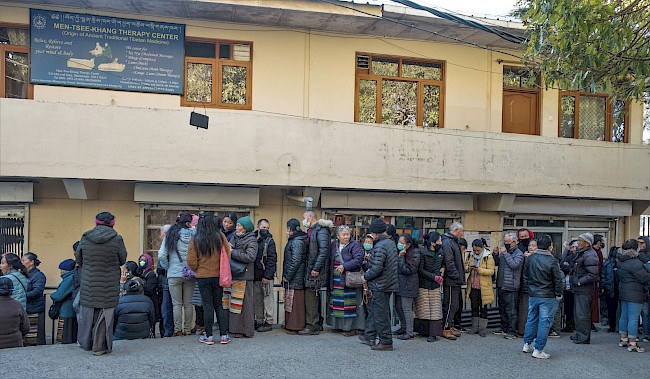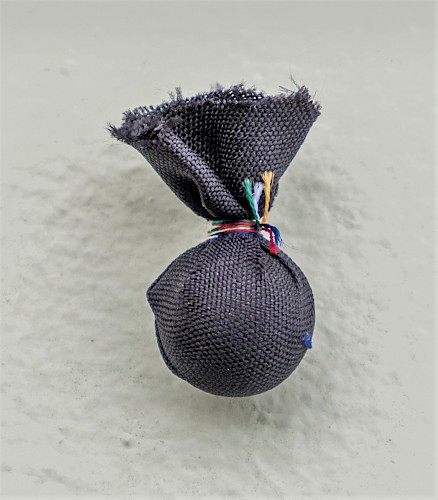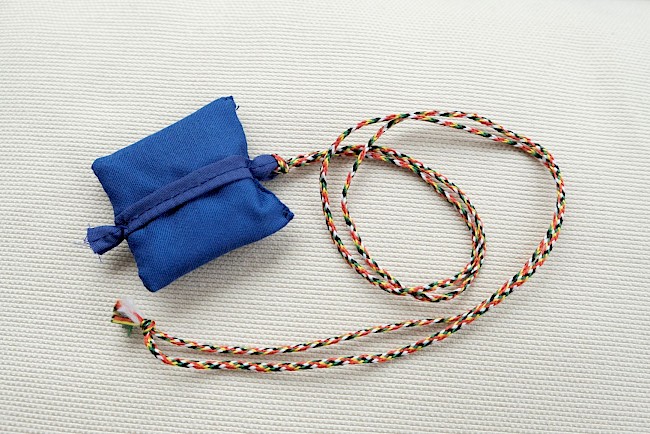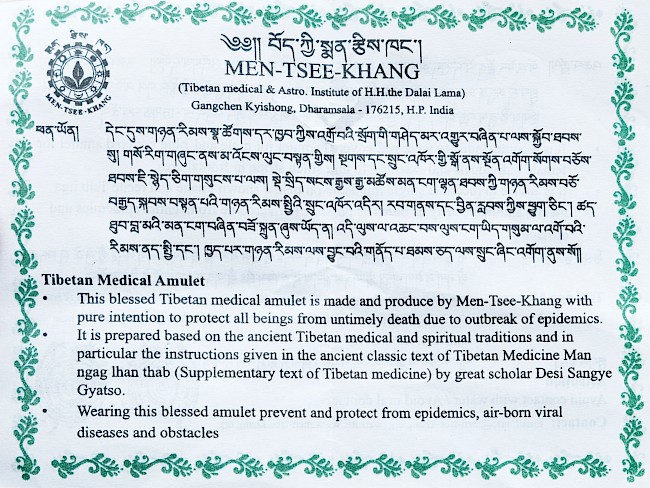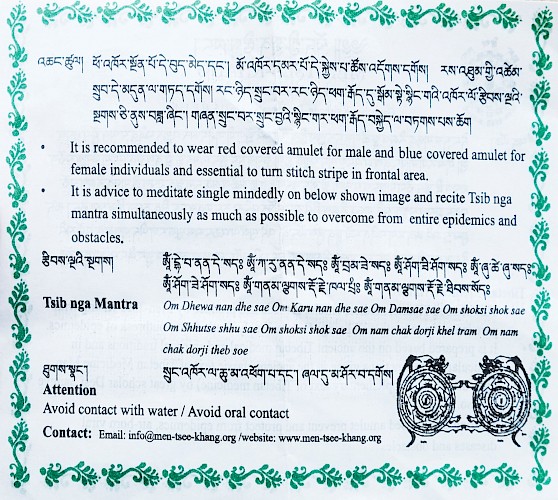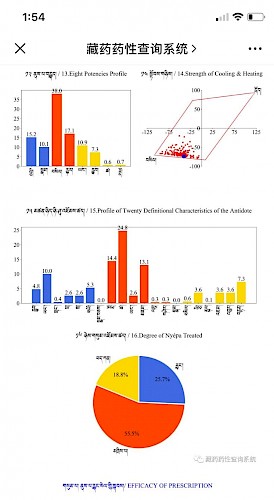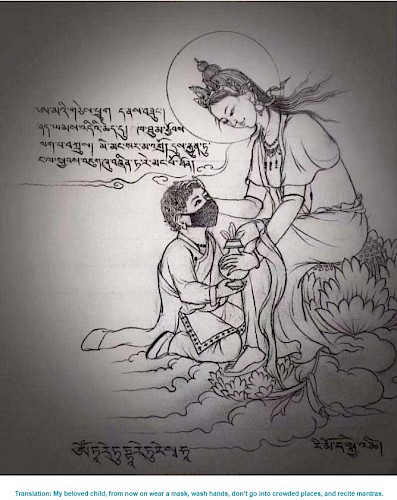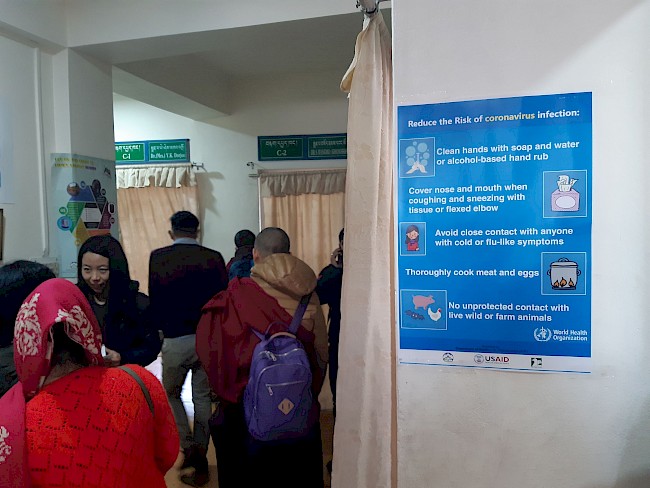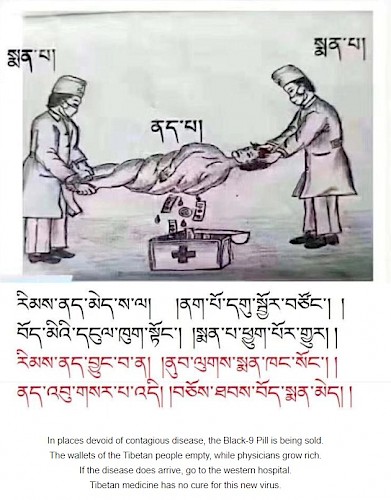Thinking through complex webs of potency
Early Tibetan medical responses to the emerging coronavirus epidemic: Notes from a field visit to Dharamsala, India
—
Abstract
1. Tibetans lining up for rimsung (‘infection protective’) pills, which are worn as amulets, at the Men-Tsee-Khang (MTK) branch clinic in McLeod Ganj, 8 February 2020.
Introduction
These notes from the field cover a short window of twelve days (7–19 February 2020). They document medical responses by Tibetans in Dharamsala to an unfolding epidemic at a time with no confirmed cases in the region. They reveal a mix of biomedical and traditional measures which challenges us to think through complex webs of potency that come to the fore at times of crisis in medical pluralistic societies. The ethnographic vignettes illustrate how different ideas of potent substances, materials, and behavior come together in a Tibetan diaspora community in an effort to protect against potential coronavirus exposure. The combined use of mantras, amulets, strong-smelling pills to be worn around one’s neck, oil-based nostril applications, wearing facemasks, and (social) media presentations on public health measures based on World Health Organization (WHO) and Tibetan medical episteme of contagion and protection raise a number of questions. In these uncertain times, what counts as medicine, and why? Who is in charge of epidemic imaginaries? How does an emerging epidemic change medical or religious notions and definitions of efficacy? And from what platforms will traditional medical systems in Asia – and specifically Tibetan medicine (Sowa Rigpa) in India – be permitted to contribute preventive and therapeutic measures based on their traditions? This Think Piece shows how contested traditional and biomedical knowledge systems merge together in public health efforts and how these processes may also be curtailed and sidelined by biomedical hegemonies.
Narratives of protection and contagion
In the late afternoon on 7 February 2020,[note 1] I reach Dharamsala, one of the centers of the Tibetan diaspora community in India and the seat of the Tibetan government in exile. At the Men-Tsee-Khang (MTK), the largest Sowa Rigpa institute in India, I run into a Tibetan friend, whom I will call Jigme. Within minutes, we have begun talking about the emerging coronavirus epidemic, now called COVID-19. Even though, at this point, only three official cases have been confirmed in Kerala, South India, the disease is on people’s minds. The topic has already spread across the Tibetan community in Dharamsala, which is frequented by Indian and foreign tourists and Buddhist pilgrims, including pilgrims from China. Since many Tibetans in the Indian diaspora have relatives living in Tibetan areas of China, at this point, Dharamsala feels quite close to the epidemic epicenters. That said, any ethnography on Tibetan medicine in China at this time with regard to COVID-19 would look totally different given that China and some Tibetan regions are already deeply affected by the disease.
When I ask Jigme if any cases have been reported here, he shows me a local newspaper clipping that Tibetans have been circulating through social media since the day before, which states that twenty people who recently came from China are under observation in a nearby hospital in Kangra. The article points to the town of Dharamsala and the Tibetan exile community living in the hill station of McLeod Ganj as ‘sensitive for Corona virus [sic] infections as many people from China and other Asian countries visit the place due to presence of Dalai Lama’ (Mohan 2020). It also reports that, because of the outbreak and his advanced age, the Dalai Lama has cancelled all public audiences and is staying in a meditation retreat.
A week later, 179 people are being monitored for COVID-19 symptoms in Himachal Pradesh (Puri 2020), and a high-level government physician tells me that several Chinese tourists are under observation in a nearby Tibetan Buddhist monastery. He adds that he receives their daily health reports and temperature checks from the local monks. During our informal conversation, I ask him how he assesses the current state of the epidemic in the Kangra district. ‘There are no reported cases, but we consider Tibetan settlements as high-risk areas for an outbreak’, he says; thus, the precaution of checking the temperature of Buddhist pilgrims from China, who often stay in Tibetan monasteries or guest houses. This physician’s comment makes me realize how Tibetan communities, who are already vulnerable as an exile community in India, are becoming the first focus of a slowly emerging public health scanner in the region. As we shall see in this essay, by the end of my stay, Tibetans’ reliance on their own traditional medical system is scrutinized and curtailed amidst concerns of epidemic fearmongering.
Jigme has a handful of Tibetan pills wrapped in black cloth and tightened with five-colored strings lying on his table; he gifts me two for protection from an emerging epidemic, at that moment still largely confined to China. In Tibetan, they are called rimsung rilbu (Tib. rims srung ril bu), meaning ‘pills that protect from contagion’ (fig. 2).
2. A rimsung pill, based on a medicinal formula, but worn as an amulet.
Rimsung pills are based on various formulas that exist in Tibetan classical medical texts. They are made by several Tibetan pharmacies in India and sold over the counter or given out for free. While they contain medicinal substances, they are not ingested but are said to protect through the strong odorous effects of around seven to nine ingredients. A similar black pill was widely used in the People’s Republic of China (PRC) during the SARS outbreak in 2003 (Craig and Adams 2008).
‘I will get them at the MTK clinic later’, I suggest. ‘You won’t get any; they are out of stock’, Jigme replies. ‘MTK already sold 100,000 pills in January; half of them were sent to Nepal’ (at the time, Nepal has one confirmed case). Jigme continues: ‘New stock will be ready in a few days, but the pills have to dry in this cold winter weather and have to be individually hand-wrapped, which is time-consuming’. The day before, I had seen on Tibet TV that the MTK had taken the additional help of twenty nuns from the nearby Dolmaling nunnery to wrap the pills (Tibet TV 2020b); I am told that, in return, they received enough pills for their entire nunnery. ‘In December, you could buy as many rimsung pills as were in stock; now they only give out two pills per person’, Jigme adds. At that point, I realize how precious the small collection of pills that he is so generously sharing with me is.
Jigme then shows me a short video clip on WhatsApp, depicting a crowd of more than fifty Tibetan monks, nuns, and laypeople, some of them wearing facemasks, queuing in front of the MTK clinic that same morning, waiting to buy their two rimsung pills. The next day, I observe a similar-sized queue of Tibetans gathering before the MTK branch clinic in McLeod Ganj (fig. 1); by 10am, the entire stock of 2,500 rimsung pills is sold out. The MTK shop next to the clinic, which sells MTK supplements, tea, incense, and books, also offers an astrological rimsung amulet. It is a cloth-covered square sachet (red for men and blue for women) containing mantras and potent substances. It has a five-colored string and is worn around one’s neck (fig. 3).
3. The blue-colored Tibetan rimsung amulet (for women) to protect from epidemics.
In the MTK shop, the box containing amulets is empty (fig. 4); the amulets were sold out the previous day. During the fifteen minutes I spend in the shop, four Tibetan customers walk in asking for the amulet, which sells for two hundred rupees (approx. US $3).
4. Rimsung amulets are sold out at the MTK shop in McLeod Ganj, 8 February 2020.
A few days later, a Tibetan physician at the MTK tells me that the amulet was developed as an over-the-counter product by the MTK a few years ago and is based on the seventeenth-century Supplement (Lhan thabs) by Dési Sangyé Gyatso, a famous scholar and the regent of the Fifth Dalai Lama. Similar rimsung amulets are mentioned in a thirteenth-century Nyingma text The Vase of Amrita (Simioli 2019) and in several classical medical texts, which emphasize the benefits of combining mantras with wearing potent substances to protect from disease (Czaja 2019). The MTK amulet contains mantras written on the printed image of a mandala surrounded by a wild boar (fig. 5). This is smeared with liquid substances that are attributed protective potency against infectious diseases, called rimné (rims nad). The amulet is tied in cloth with a five-colored string in a complex way by trained specialists, which I am told by an MTK astrologer takes at least half an hour per amulet. The user should recite the mantra and visualize the image for protection, but explanatory leaflets have long been out of stock, and I can only photograph one (fig. 5).
5. The two-page leaflet of the MTK protective amulet with the anti-infectious disease mantra and the image of the wild boar.
Some of the amulet substances are also ingredients of the MTK rimsung pill and the Nine-Ingredient Black Pill (nag po dgu sbyor, also ril bu dgu nag), which became famous during the 2003 SARS outbreak. Sienna Craig and Vincanne Adams (2008) were in Lhasa at that time and documented how these black pills, along with other amulets and incense, became bestsellers in Tibet and were shipped to mainland China for SARS protection. The Tibetan Autonomous Region also donated and sold Tibetan medicine to mainland China (ibid., 24). The SARS epidemic, which affected around eight thousand people worldwide and caused 774 deaths, led to a revival of Tibetan medicinal products that were otherwise considered too esoteric by Chinese government officials to be deemed effective against an epidemic. Craig and Adams (ibid., 24) argued that during the SARS outbreak, Tibetans ‘were given a legitimate chance to express aspects of their identity that at other historical moments would have been shunned as “superstitious”’. During the SARS epidemic, many Tibetans, as well as Chinese, perceived Tibetan amulets and formulas as effective. This was supported by beliefs that attributed the SARS-free Tibetan areas in the PRC to the spirituality of high lamas and the special potency of substances grown on the pure high Tibetan plateau (ibid., 23–24).
As of 17 February 2020, there are more than eight hundred COVID-19 cases in Tibetan areas of the PRC, largely in Sichuan (Tenzin Dharpo 2020a). In Tibetan areas unaffected by the coronavirus, a perspective similar to the one described above is retained – attributing efficacious protection to the presence of spiritual masters. In the affected areas, however, different questions are raised, even though the medico-religious formulas and amulets produced and circulated are the same (Tawni Tidwell, personal communication, 26 February 2020). Will an outbreak change how people view the efficacy of their traditions? Will Tibetan doctors have the opportunity to test their range of medicines during this epidemic? Will government rules, which greatly differ in the PRC and India, allow Tibetan physicians to practice? Researching and finding answers to these questions in the course of this epidemic will reveal ways in which Sowa Rigpa has established itself, especially since SARS, as a medical system across Asia capable of supporting public health in an epidemic outbreak. Might it follow a similar trajectory to Traditional Chinese Medicine (TCM), which currently contributes effectively to the treatment of COVID-19 in China (Sun and Hsu, forthcoming)?
As of the time of writing, there are signs of both trust and doubt in what Tibetan medicine has to offer in treating epidemic-level infectious disease. On social media, Jigme shares a short humorous video clip in which a Tibetan man, wearing a facemask and seven amulets around his neck, sarcastically claims that he will be saved from COVID-19. This contrasts with the approach taken by Tibetan medical institutes in Tibetan areas of the PRC, which have treatment plans for COVID-19 in place – some of which are shared via social media. These plans include many formulas, and their protocols are tailored to descriptions of symptoms and etiologies that have been released on COVID-19 so far (Tidwell, forthcoming).
Within five days of arriving in Dharamsala, I have seen about 120 links on social media with information on rimné topics being circulated among Tibetan doctors. Largely from the PRC, these doctors share short articles in Tibetan on epidemiology, various rimsung pills, and common formulas to treat infections. Tibetan physicians recommend and discuss formulas they would use should they happen to treat a patient with COVID-19 symptoms. For example, Dr. WüntrangDhondrup, a young Tibetan scholar physician, trained in Xining and working at the Ethnic Medicine Academic Heritage Innovation Research Center in Chengdu, Sichuan, circulates seventy-seven Sowa Rigpa formulas to treat rimné via social media. Dr. Dhondrup has become known for his innovative use of bioinformatics in the analysis of Tibetan formulas, such as the Nine-Ingredient Black Pill (nag po dgu sbyor; fig. 6). He and colleagues recently developed these mathematical methods to analyze large amounts of Sowa Rigpa historical and contemporary medical data, from disease categories to treatment and formulas (Dhondrup et al. 2020).
6. Sample page of Dr. Dhondrup’s informatics methods applied to illustrate the potencies and characteristics of the Nine-Ingredient Black Pill rimné formula, circulated via social media.
The potency of smell and ideas of contagion
The corpus of Sowa Rigpa medical knowledge has a large arsenal of rimné substances that are formulated and used across Tibet and in exile, including the rimsung pill. The potency of the rimsung pill unfolds from the strong smell – both fragrant and unpleasant – of its ingredients, which include garlic (sgog), sulfur (mu zi), types of aconite (sman chen), types of myrrh (gu gul), and traditionally also musk (gla rtsi). I am told to wear the pill around my neck and smell it regularly. The smell is subtle, but unpleasant. Once the smell disappears, the pill has lost its efficacy.
How does an approximately thirteenth-century formula used as an amulet, which bases its potency on the power of smell (dri ma’i nus pa) and the ‘fragrant essence’ of substances (rtsi’i nus pa) – so fundamental to pre-modern ideas of contagion – become a popular preventive measure during a viral outbreak in the twenty-first century? Medical historians Lawrence Conrad and Dominik Wujastyk (2010, ix) have shown that even ‘today, popular beliefs about disease causation are by no means always closely aligned with the current medical orthodoxy’. Their edited volume Contagion: Perspectives from Pre-modern Societies (Conrad and Wujastyk 2010) illustrates how ideas of contagion and transmission have, in many societies, been linked to notions of danger, virulence, proximity, and ideas of pollution, leading to different ‘outbreak narratives’ (Wald 2008) when compared to microbes.
Medical historians have pointed out that conceptions and the identity of infectious disease have changed over time, and pre-laboratory concepts of pathogens are often difficult to define retrospectively (Cunningham 2002, 209). Thus, I am careful when translating classical Tibetan medical terms related to epidemics and contagion, in an effort to make accurate reference to the current context in which these terms are used and avoid creating erroneous narratives of contagion of the past. Historically, Tibetan authors expressed their ideas of contagion and virulence using the concepts of nyen (gnyan), rim (rims), and nyenrim (gnyan rims). Their definitions overlap but also differ in classical Sowa Rigpa and Buddhist medical texts and have acquired different meanings over time. Nyen in classical texts translates as ‘spirit’ that causes a nyenrim or infectious disease. Nyenpa (gnyen pa) refers to something cruel, fierce, or severe, such as a plague (Czaja 2019, 289). Historically, nyen refers both to types of spirits and to categories of specifically serious or malignant diseases caused by tiny organisms called sinbu (srin bu).[note 2]
Tibetan doctors in Xining, Lhasa, and Dharamsala think of nyen as caused by sinbu; linking nyen to a virus or bacteria is rather new for Sowa Rigpa practitioners (Tawni Tidwell, personal communication, 9 February 2020). On 5 February, on Tibet TV out of Dharamsala, the MTK physician Dr. Tenzin Lhundrup describes nyen as ‘type of microbes which are harmful for the body’ (Tibet TV 2020b). She refers to a specific ‘microbe’ called parpata (parpa ta), which causes fever and a progressive disease called nyenrim. Correlating COVID-19 to descriptions of infectious diseases in the fundamental thirteenth-century Tibetan medical work Four Treatises, Dr. Lhundup would classify COVID-19 as a type of nyenrim. Likewise, Tibetan doctors would classify the plague, Ebola, and SARS ‘as nyenrim illnesses (gnyan rims), a particularly contagious form of nyen’ (Tidwell 2019: 159n66).[note 3]
An early Buddhist medical text describes rim as passing through ‘“air” (rlung) and “smoke” (du ba) emanating from the “disease breeding ground” (nad yod sa)’ and eventually becoming an epidemic (Simioli 2019, 228). Further, rim is caused by forms of impurities or drima (dri ma), for example, ‘deriving from contacts with impure substances (human and animal), [and] the pungent odors of infected bodies (nad dri)’ (ibid., 228). Overall, unpleasant smells and pestilential vapors are emphasized as causing nyen and rim. Both nyen or rim enter the body through the upper respiratory pathways, then spread throughout and affect different organs (ibid., 228). The infectious disease chapters in the Four Treatises emphasize contagion through spoiled foods, unclean things, and so forth (Tawni Tidwell, personal communication, 25 February 2020). Overall, the term nyenrim refers to complex infectious diseases which can be contagious.
In Tibetan texts, epidemic-causing drima refers to anything dirty, harmful, and filthy. Drima can mean leftovers or garbage left in spirit abodes, or having contact with impure animal parts or burning animal parts such as fur, skin, or bones (Simioli 2019, 229). Drima also refers to immoral actions, which in the COVID-19 case includes the mindless consumption of wild animals. These ideas of drima and contagion make it easy for Tibetans to relate to current zoonotic hypotheses of SARS-CoV-2 jumping from animals to humans (Fearnley 2020). Such tentative discoveries, however, raise delicate questions regarding the continued use of ‘fragrant essence’ animal substances in TCM and Sowa Rigpa. Pangolin scales (na gi,also chu srin sder mo), for instance, are aromatic, known to be illegally traded on a large scale, and are used in some incense as well as medicines. Pangolins have also been earmarked as possible intermediate hosts of SARS-CoV-2, but this as yet unconfirmed discovery also has the potential to exacerbate scapegoating and reinforce racial and scientific hierarchies and othering.[note 4]
The point I wish to make here is that the use and interpretations of terms related to epidemics in long-established Asian medical traditions have to be carefully unraveled in their historical textual and current ethnographic and clinical interpretations. Concepts such as drima, sinbu, and nyen meld medical and moral imaginations of what comprises an act of contagion in fluid ways over time. As we shall see next, they also add different ideas to the ‘web of potency’ in an effort to protect from an emerging epidemic.
Approaching epidemics – assembling potencies
What to make of these multidimensional protective measures for an emerging epidemic? How can we think with and through this ongoing epidemic anthropologically, and from the perspective of Asian medical traditions such as Sowa Rigpa? The Tibetan exile case gives food for thought, since we can see how an understanding of modern public health measures merges with long-established preventive formulas as a first response to this epidemic. In Dharamsala, at the end of January, the senior MTK physician Dr. Tsewang Tamdin explained on Tibet TV that Sowa Rigpa preventive measures combine the potency of substances with mantras (Tibet TV 2020a). This includes wearing amulets, smelling rimsung pills, consuming blessed pills that have been consecrated with mantras (such as mani rilbu), offering fragrant incense to purify and protect spaces, meditating, and reciting mantras. These practices are aimed at creating spaces of emotional stability and ethical conduct cultivating less fear, less panic, and more empathy. Tibetan medical practitioners present these practices as preventive measures, emphasizing Sowa Rigpa concepts of balance and potency. For example, on Voice of Tibet, Dr. Rigzin Sangmo of the MTK advocates combining the potency of substances, smell, fragrance, mantra, as well as balancing one’s mind through mantra recitation and one’s nature through timely food, rest, and good hygiene (Voice of Tibet 2020). On Tibet TV, Dr. Tenzin Lhundrup of the MTK in Dharamsala also emphasizes these preventive measures, since treating nyenrim can be very challenging (Tibet TV 2020b).[note 5] At the end of January, the Central Tibetan Administration issued a statement by the Dalai Lama, in response to a request by Chinese devotees, that chanting the Tārā mantra would be ‘helpful in containing the spread of epidemics like Coronavirus’ (CTA 2020). Notably, all these measures are presented as prevention and protection, not as a cure for COVID-19.
As is often the case in medically pluralistic societies, relying on traditional means does not exclude modern public health measures – as the use of facemasks shows, discussed next.
Risk rituals: Facemasks
Facemasks have been described by anthropologists as both ‘potent symbols of existential risk’ and as ‘indispensable technology against epidemics’, thus combining symbolic with practical medical reasoning (Lynteris 2018, 442). Wearing a mask and chanting mantras, though based on different epistemologies, do not contradict each other in Tibetan responses to COVID-19 (fig. 7); rather, they are part of the multivalent resources that people mobilize to feel protected.
7. An awareness-raising call in Tibetan to wear facemasks and recite mantras, circulated on social media (see Thubten Phuntsok and McGrath 2020). The translation by McGrath reads: ‘My beloved child, from now on wear a mask, wash hands, don’t go into crowded places, and recite mantras’.
However, facemasks might also create ambivalences, since they merge notions of caution, merit, and karma. In Tibetan societies, reasons for contracting a disease are often framed within Buddhist notions of karma, implying that current events are the outcome of one’s previous actions. I encounter this in Dharamsala, while talking to some Tibetans queuing for rimsung pills at the MTK clinic. I ask questions about their ideas of prevention and protection related to coronavirus. A young Tibetan man who is not wearing a mask says: ‘It is your karma if you get this virus or not – with or without a mask. I never wear a mask, but the black pill really works for protection’. Since ideas of karma and merit can easily merge with other cautionary practices, such as wearing a facemask, but might also stop people from implementing these, current social media awareness messages in the Tibetan language often present them together (fig. 7).
During the second day of my stay in Dharamsala, I stop by a chemist shop in McLeod Ganj, which has two types of facemasks in stock: surgical facemasks for five rupees and more sophisticated masks for 130 rupees; the recommended N95 masks, for 170 rupees, are out of stock. A Tibetan couple in front of me buys the available 130-rupee model. I ask the Tibetan shopkeeper about his sales of masks linked to coronavirus. ‘If you face a coronavirus patient with or without a mask’, he says, ‘you’ll get it; there is no full protection through these masks’. In just the past two weeks, he has sold two thousand N95 masks, a six-month stock under normal circumstances. He comments: ‘Only Tibetans buy them, Indians are less concerned about pollution and contagion, or don’t want to spend the money’. He tells me that many Tibetans buy N95 masks here and mail them to Tibet, where there is a shortage. I ask him what he thinks about the rimsung pills as a method of protection. ‘I don’t believe in this’ is his brief answer. A walk through McLeod Ganj confirms his observation about masks: I only see Tibetans and Asian tourists wearing facemasks. None of the local Indians or the Indian tourists frequenting this hill station do so. I cannot ask enough people to find out the reasons, but my impression is that Tibetans seem more cautious, perhaps due to the social media news they receive on COVID-19 through Tibetans in China.
Later, walking down the road with my N95 facemask, which I often wear in India because of the air pollution, I suddenly experience a new dimension of this ‘risk ritual’ (Lasco 2020) and its comfort as a ritualized epidemic control mechanism (Lynteris 2018). I understand why anthropologists have argued that masks might confer a sense of self-protection, but also express shared collective values of protecting each other and feeling more in control of contagious uncertainties, while concealing fears and faces (Lasco 2020). At the MTK shop, I ask whether Tibetans here are really afraid of the coronavirus. The saleswoman says: ‘Not so much, but since the news on the Kangra cases came out, fear is there. People here trust pills more than masks’. She laughs. ‘We are not used to wearing masks; it is uncomfortable’. The next day, I get a similar response at the main MTK clinic where none of the staff wears them. The woman at the reception says: ‘We have to talk to so many people every day; wearing a mask is uncomfortable’. Still, many Tibetans wear a facemask in public.
‘Science’ and ‘tradition’ mingle in public health efforts to inform Tibetans in exile about preventive measures (fig. 8). Tibet TV streams two thirty-minute shows, in Tibetan and English, each with a biomedical and a traditional Tibetan physician discussing prevention of coronavirus (Tibet TV 2020a, 2020b). While the biomedical doctors present standard WHO advice on hygiene, washing hands, coughing in one’s sleeve, wearing masks, and so on, the Tibetan physicians primarily draw on the Four Treatises, which has designated chapters on infectious diseases, gives dietary and behavioral advice, and lists formulas to prevent and treat epidemics.
8. A Department of Health (Central Tibetan Administration) poster, following WHO guidelines, at an MTK clinic selling Tibetan medicines.
Why does it make sense for Tibetans to rely on their authoritative texts and long-standing medical tradition in times of crisis? One Tibetan physician in Dharamsala explained it to me this way: ‘These texts are old, but they mention the future degenerate times we are living in now, and advise which formulas to use for new epidemics. The formulas are already there, only the disease is new’. Relying on tradition here gives certainty in times of uncertainty. We have seen how, in 2003, TCM approached SARS not as a new disease but rather as a ‘familiar Hot Wind disorder within the broader wenbin category’, and treated it as a ‘heat wind epidemic’ with related formulas alongside biomedicine (Hanson 2011, 163–164). Tibetan physicians are likewise ready to apply their Sowa Rigpa theories and formulas to treat COVID-19. In Sowa Rigpa, traditional rimné formulas are often reformulated and the synergy of ingredients can be adjusted to treatment needs, such as directing formulas with additional herbs to benefit the upper respiratory tract. The Tibetan physicians I spoke with are confident about their long-tested arsenal of medicines to treat many of the COVID-19-related symptoms and strengthen the body to fight the disease. How they do this is complex and these practices are different from the preventive usage of amulets and protective pills for the public described in this Think Piece. In Dharamsala, MTK-made formulas and their ingredients are considered secret specialized knowledge, which is not publicized. In February, I saw only Tibetan doctors from the PRC circulating details on formulas and their COVID-19 treatment plans via social media.
Pathways of protection and contagion
During the initial Tibetan medical preventive initiatives in Dharamsala – before there were any positive cases in the area – I notice how ideas of protection and contagion are also shaped by ways in which Tibetans pass on (mis)information about the MTK products and potential vectors who could bring the epidemic to Dharamsala. Below, I show such pathways of epidemic information on protection and contagion and discuss how they might frame potential ‘outbreak narratives’ (Wald 2008).
Ideas of protection and contagion blur in how epidemic news and the available preventive products trigger different notions of potency and toxicity. An example: apart from the black pill, the MTK also produces a ‘protective liquid balm’, an oil-based roll-on called A drop of nectar to stop infectious diseases (nad ’gog bdud rtsi’i thigs pa). It is advertised to help ‘prevent common colds & flu’ and prevent ‘risk of infectious respiratory illness’. It should be applied to the nostrils – the entrance point of many airborne infections – several times a day. The oil was developed before the coronavirus epidemic broke out, but is receiving a new significance these days.
Talking to Tibetans queuing for the rimsung pill, one young man tells me that the black pill contains a poison (aconite) which makes it efficacious. He does not like to buy the oil because he thinks it works on the same basis as the pill (i.e., it also has poisonous substances inside). He says: ‘Here, people don’t go for the oil, because it can accidentally enter the mouth or enter the body through the skin and cause some toxicity. It is supposed to work based on smell, not on ingestion’. Since there is no leaflet and no description on the label, ideas of its content and efficacy largely spread by word of mouth and media. One Tibetan physician was critical of the oil, considering it a potential carrier of contagion: ‘Who is going to wash hands before applying the oil? It can actually increase contagion when you apply oil on your unwashed palm and then touch your nostrils’.
Walking down Temple Road, I observe one of the many Tibetan souvenir street vendors applying the oil to a young girl’s nostrils and then to his own. Curious, I begin a conversation. He got his rimsung pill eight days ago and tells me that his family in Tibet has asked him to send these MTK products. Even though rimsung pills are produced in Tibet, the proximity to the Dalai Lama attributes a higher efficacy to pills made here. He also wears a mask to protect himself from tourists, currently considered vectors of contagion. Politics and fear of ‘the other’ merge with traditional products of prevention and protection.
Recently, the WHO has warned on their website of the ‘infodemic’ risk of incorrect and xenophobic information on COVID-19 circulating online. During my visit to Dharamsala, I note that tourists from China are treated with extra suspicion. The same street vendor I talk to about the rimsung oil tells me that he knows from social media where Chinese tourists stay and how they move about town. He says the Chinese are angry with their government, and shows me three short video clips on his Facebook and WeChat accounts showing Chinese spreading the virus on purpose by spitting on public surfaces somewhere in China. Whether fake news or not, these are viral expressions of dissent: the destabilization of China by the spread of COVID-19 fuels his hope for a ‘Free Tibet’.
Another social media ‘joke’ going around is a skit in Hindi, where a group of youngsters run away the moment they hear their friend just returned from China. What will happen to Tibetan communities, who are already earmarked as sensitive and vulnerable in India, if there is an outbreak? Who will become the target of blame? How toxic will the ‘outbreak narratives’ (Benton 2020; Wald 2008) become?
Economics of epidemics
A brief glance into the economics of Tibetan preventive enterprise illustrates that among Tibetan doctors themselves, views on traditional Tibetan epidemic responses differ. Epidemics typically cause huge financial losses and can stir up economic crises, yet they also provide financial opportunities for those producing products of protection. At the MTK, the rimsung pills are sold for twelve rupees per pill (less than US $0.20) – cheaper than the complexprecious pills used for severe disease,[note 6] but more expensive than more common, day-to-day essential medicines. ‘This is probably less than the cost of production and an act of charity and a public health care measure by the MTK’, says the MTK physician, Dr. Rigzin Sangmo, who also spoke about MTK rimsung products on Voice of Tibet.
As with most medicines, even outside times of crisis, financial exploitation happens. In some places, the high demand has led to high prices. Some of these rimsung pills are traded and re-sold in Nepal and Tibet for around one hundred to three hundred rupees per pill (I also heard rumors of 1,500 rupees per pill), or mailed to relatives in Tibet along with N95 protection masks. I also heard that many Tibetan physicians in China have begun to distribute rimsung pills for free. In McLeod Ganj, only Dr. Kelsang Dhonden’s clinic did this, distributing three pills per person (Jampa Choephel 2020).
9. Poem by Dr. Thubten Püntsok (see Thubten Phuntsok and McGrath 2020).
In a recently published poem, the Tibetan scholar-physician Thubten Püntsok from Chengdu strongly critiques sale practices and expresses doubts about the efficacy of Tibetan medicine for COVID-19, advising patients to go to a biomedical hospital if they contract COVID-19 (fig. 9). He writes that ‘physicians grow rich’, though it might be more the Sowa Rigpa pharmaceutical companies than individual physicians that profit from the sales. While biomedical hospitals are essential to provide breathing assistance for severe cases of COVID-19, this epidemic might offer opportunities to show whether Tibetan formulas will give relief during different stages of COVID-19. Thubten Püntsok’s criticism, as such, is exceptional among Tibetan physicians in the PRC, who in general are actively getting ready to alleviate symptoms of COVID-19 through their long-standing formulas, as well as through reformulations (Tidwell, forthcoming).
Conclusions
This vignette ends on 19 February, when the Chief Medical Officer (CMO) of Kangra district ordered two clinics (MTK and Dr. Kalsang Dhonden’s clinic) to stop distributing rimsung pills because they were causing anxiety and panic among the people at a time when there are no positive COVID-19 cases in the state, let alone in the district (Kelzang Chinpa 2020). What the CMO perceived as causing panic and anxiety is the opposite of what the pills are purported to do within the Tibetan cultural context – namely, make people feel safe. MTK accepted the order since ‘non-compliance to the directive may result in fines up to 10,00,000 INR [Indian rupees] and even closure of the clinic while demanding conclusive scientific study that supports claims that it prevents contagious diseases’ (Tenzin Dharpo 2020b). The MTK director responded that the MTK ‘has not advertised or made claims regarding the pill as it is formulated from the ancient texts and has been around for centuries’ (ibid.). Moreover, he argues: ‘since the pill is not for oral consumption and is to be administered only through smell, does the issue come under the purview of concerned authority?’ (ibid.). This encounter between biomedical and traditional medical institutions raises questions around not only when and why rimsung pills count as medicines, but also who controls this narrative. What can we conclude from these early Tibetan responses to an emerging epidemic, which at the time of publishing has become a pandemic spreading to over 180 countries? The ethnographic vignettes illustrate much broader issues at stake: when ‘local’ medical responses are curtailed by biomedical public health hegemonies, the ‘politics of prevention’ becomes a contested place. Here, different epidemic imaginaries challenge, direct, and control what counts as protection and prevention, as fearmongering and anxiety-causing, or what qualifies as ‘medical’ prevention – for example, substance-enhanced amulets that affect through smell and mantras.
In these times of crisis, people could draw on the web of potencies that exist in their local communities which, in addition to known public health measures, often rely on their traditional health systems. In communities that use Sowa Rigpa, rimsung pills – whether defined as medicines or amulets – could easily be distributed while avoiding queues and applying methods of ‘social distancing’. What is at stake is the loss of locally (not necessarily scientifically) tested, traditional methods to handle the fear and anxiety that accompany an unknown epidemic – and, thus, help prepare and strengthen communities to face it.
Acknowledgements
Special thanks to all the Tibetans who informally discussed the rimsung pill, oil, and amulet with me. Thanks to William McGrath, Tawni Tidwell, and Jan van der Valk for sharing online posts, thoughts, and comments. I also thank the MAT section editor, Martha Lincoln, for her useful edits and suggestions. This research was supported by the FWF (grant 30804) through the University of Vienna. Photos are by the author unless otherwise indicated.
About the author
Barbara Gerke (M.Sc., D.Phil. Medical and Social Anthropology, University of Oxford) has completed a German Research Foundation (DFG)-funded project on Tibetan mercury practices (2011–2015) and an Austrian Science Fund (FWF) Lise-Meitner senior research fellowship (2015–2018) on Tibetan precious pills. She currently leads a three-year FWF-funded project at the University of Vienna (2018–2021) on Tibetan ritual and medical understandings of potency. She is the author of Long Lives and Untimely Deaths: Life-Span Concepts and Longevity Practices among Tibetans in the Darjeeling Hills, India (Brill, 2012) and Taming the Poisonous: Mercury, Toxicity and Safety in Tibetan Medical Practice (Heidelberg University Publishing, in press). She is also currently co-editing a special Hot Spots issue on Asian Medicines and COVID-19 for Cultural Anthropology, together with Sienna Craig and Jan van der Valk.
References
Benton, Adia. 2020. ‘Race, Epidemics, and the Viral Economy of Health Expertise’. The New Humanitarian, 4 February. https://www.thenewhumanitarian.org/opinion/2020/02/04/Coronavirus-xenophobia-outbreaks-epidemics-social-media.
Conrad, Lawrence I., and Dominik Wujastyk. 2000. Contagion: Perspectives from Pre-modern Societies. Aldershot: Ashgate.
Craig, Sienna, and Vincanne Adams. 2008. ‘Global Pharma in the Land of Snows: Tibetan Medicines, SARS, and Identity Politics Across Nations’. Asian Medicine 4 (1): 1–28. https://doi.org/10.1163/157342108X381205.
CTA. 2020. ‘Chanting Tara Mantra Helpful in Containing the Spread of Epidemics Like Coronavirus: His Holiness the Dalai Lama to Chinese Devotees’. Central Tibetan Administration: Restoring Freedom for Tibetans, 28 January. https://tibet.net/chanting-dolma-mantra-helpful-in-containing-the-spread-of-epidemics-like-coronavirus-his-holiness-the-dalai-lama-to-chinese-devotees/.
Cunningham, Andrew. 2002. ‘Transforming Plague: The Laboratory and the Identity of Infectious Diseases’. In The Laboratory Revolution in Medicine, edited by Andrew Cunningham and P. Williams, 209–244. Cambridge: Cambridge University Press.
Czaja, Olaf. 2019. ‘Mantras and Rituals in Tibetan Medicine’. Asia Medicine 14 (2): 277–312. https://doi.org/10.1163/15734218-12341454.
Dhondrup, Wüntrang, Tawni Tidwell, Xiaobo Wang, Dungkar Tso, Gönpo Dhondrup, Qingfang Luo, Choknyi Wangmo, Tsering Kyi, Yongguo Liu, Xianli Meng, and Yi Zhang. 2020. ‘Tibetan Medical Informatics: An Emerging Field in Sowa Rigpa Pharmacological & Clinical Research’. Journal of Ethnopharmacology 250. https://doi.org/10.1016/j.jep.2019.112481.
Fearnley, Lyle. 2020. ‘The Pandemic Epicenter: Pointing from Viruses to China’s Wildlife Trade’. Somatosphere, 6 March. http://somatosphere.net/forumpost/wild-virus/.
Gerke, Barbara. 2015. ‘The Poison of Touch: Tracing Mercurial Treatments of Venereal Diseases in Tibet’. Social History of Medicine 28 (3): 532–554. https://doi.org/10.1093/shm/hkv016.
Hanson, Marta. 2011. Speaking of Epidemics in Chinese Medicine Disease and the Geographic Imagination in Late Imperial China. London: Routledge.
Jampa Choephel. 2020. ‘Dr. Kalsang Dhonden free distribution of precious Tibetan black pill’. YouTube, 13 February. https://www.youtube.com/watch?v=rwwXA_uSK3c&t=4s.
Kelzang Chinpa. 2020. ‘ཀང་རཱ་རྫོང་ཁོངས་སུ་རིམས་སྲུང་རིལ་བུ་བཙོང་མི་ཆོག་པའི་བཀའ་ཁྱབ་བཏང་།’. Tibet Times, 18 February. http://tibettimes.net/2020/02/18/183638/.
Lasco, Gideon. 2020. ‘Why Facemasks are Going Viral’. Sapiens, 7 February. https://www.sapiens.org/culture/coronavirus-mask/.
Lynteris, Christos. 2018. ‘Plague Masks: The Visual Emergence of Anti-Epidemic Personal Protection Equipment’. Medical Anthropology 37 (6): 442–457. https://doi.org/10.1080/01459740.2017.1423072.
Mohan, Lalit. 2020. ‘Corona Virus: 20 Kangra Residents under Scanner’. The Tribune, 6 February. https://www.tribuneindia.com/news/corona-virus-20-kangra-residents-under-scanner-36424.
Puri, Shri. 2020. ‘Coronavirus: Eight Under Watch in Kangra of Himachal Pradesh’. The Times of India, 16 February. https://timesofindia.indiatimes.com/city/shimla/coronavirus-eight-under-watch-in-kangra-of-himachal-pradesh/articleshow/74164689.cms.
Simioli, Carmen. 2019. ‘Knowledge, Imagery, and the Treatment of Communicable Disease in the Vase of the Amṛta of Immortality: A Preliminary Analysis of a Nyingma Medical Corpus’. In Tibetan Medicine in Context, PIATS 2016, Tibetan Studies: Proceedings of the Fourteenth Seminar of the International Association for Tibetan Studies, Bergen, 2016, edited by William McGrath, 218–260. Leiden: Brill. https://doi.org/10.1163/9789004404441_008.
Sin, Xun, and Elisabeth Hsu. Forthcoming. ‘COVID-19: Recommendations for TCM Treatment’. Cultural Anthropology: Hot Spots Special Issue on Asian Medicines and Covid-19, edited by Sienna Craig, Barbara Gerke, and Jan van der Valk.
Tenzin Dharpo. 2020a. ‘Over 850 Confirmed Cases, 5 Deaths Due to COVID-19 in Occupied Tibet’. Phayul, 17 February. https://www.phayul.com/2020/02/17/42631/.
Tenzin Dharpo. 2020b. ‘Men-Tsee-Khang to Stop Selling Pill that Claims to Prevent Contagious Diseases after District CMO’s Intervention’. Phayul, 19 February. https://www.phayul.com/2020/02/19/42637/ .
Thubten Phuntsok, and William McGrath. 2020. ‘Masks, Mantras, and the Black-9 Pill: Thubten Phuntsok and Tibetan Netizens on Coronavirus and Tibetan Medicine’. High Peaks Pure Earth, 4 February. https://highpeakspureearth.com/2020/masks-mantras-and-the-black-9-pill-thubten-phuntsok-and-tibetan-netizens-on-coronavirus-and-tibetan-medicine/.
Tibet TV. 2020a. ‘(འདོན་ ༢༥༤) ཏོག་དབྱིབས་ནད་དུག་ལས་བྱུང་བའི་གློ་ཚད་ཀྱི་རིམས་ནད་སྔོན་འགོག་བྱ་ཚུལ།’. YouTube, 29 January. https://www.youtube.com/watch?v=EySW62PvpbQ.
Tibet TV. 2020b. ‘Tibetan Doctors Speak on Coronavirus to Tibet TV’. YouTube, 5 February. https://www.youtube.com/watch?v=xxtSM1-6wok.
Tidwell, Tawni. 2019. ‘The Modern Biomedical Conception of Cancer and Its Many Potential Correlates in the Tibetan Medical Tradition’. In Tibetan Medicine in Context, PIATS 2016, Tibetan Studies: Proceedings of the Fourteenth Seminar of the International Association for Tibetan Studies, Bergen, 2016, edited by William McGrath, 141–196. Leiden: Brill. https://doi.org/10.1163/9789004404441_006.
Tidwell, Tawni. Forthcoming. ‘COVID-19 and Tibetan Medicine: An Awakening Tradition in a New Era of Global Health Crisis’. Cultural Anthropology: Hot Spots Special Issue on Asian Medicines and Covid-19, edited by Sienna Craig, Barbara Gerke, and Jan van der Valk.
Voice of Tibet. 2020. ‘Benefits of Rimsung Rilbu and Other Alternative Sowarigpa Options Amidst Coronavirus Outbreak’. YouTube, 30 January. https://www.youtube.com/watch?v=RXVFU-xo6ec&t=146s.
Vyawahare, Malavika. 2020. ‘Illegal Pangolin Trade may have Played a Part in Coronavirus Outbreak’. Mongabay, 13 February. https://news.mongabay.com/2020/02/illegal-pangolin-trade-may-have-played-a-part-in-coronavirus-outbreak/.
Wald, Priscilla. 2008. Contagious: Cultures, Carriers, and the Outbreak Narrative. Durham, NC: Duke University Press.
Endnotes
1 Back
When I began writing this Think Piece on 8 February, the official numbers were 37,198 confirmed infections in China and more than five hundred deaths. By the time I had completed it twelve days later, the figures had doubled in China, but there were no further reported cases in India.
2 Back
Sinbu refer to entities that reside in the body and lead to radiance and longevity in a balanced state, and, when imbalanced, produce disease (see Tidwell 2019, 152n37). Foundational Tibetan medical texts describe sinbu as tiny beings that can live in blood and move anywhere in the body, causing nyen disease (Czaja 2019: 290, 302).
3 Back
I have previously discussed other ideas of contagion in Tibetan medicine, specifically those linked to concepts of poison, which are prominent in Tibetan medical understandings of venereal diseases (Gerke 2015).
4 Back
Thanks to Jan van der Valk for pointing this out in an e-mail communication, 15 February 2020. See also Vyawahare 2020.
5 Back
See Tidwell (forthcoming) for contrasting views on the Tibetan plateau.
6 Back
Eight types of precious pills (containing between twenty-five and around 160 herbal, mineral, precious stones, and organo-metallic ingredients) are produced at the MTK in Dharamsala. Of these, one type (Rinchen Mangjor Chenmo) has been recommended on Tibet TV as a COVID-19 preventative.
